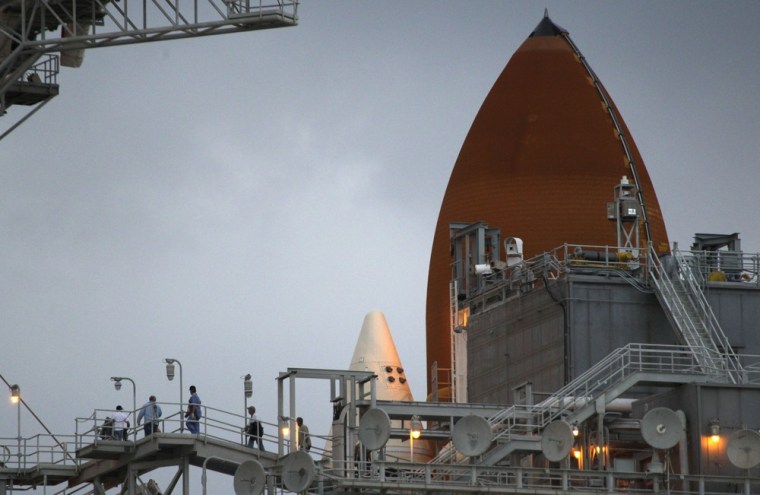The final launch of space shuttle Discovery has been delayed again, this time because of an electrical problem.
NASA decided early Tuesday evening to bump the liftoff until at least Thursday. The decision came less than 24 hours before the scheduled launch on Wednesday.
The space agency has until Sunday — possibly as late as Monday — to send Discovery to the International Space Station. Otherwise, it will have to wait until December because of sun angles.
Gas leaks had already forced a two-day postponement for Discovery's last trip into orbit.
"Discovery is not going out easy," said launch director Mike Leinbach. "She's giving us a little bit of trouble, but that's fine. She'll fly perfectly when she does."
The weather may keep Discovery grounded even longer. Looking ahead to Thursday, forecasters said there is a 70 percent chance that rain and perhaps even thunderstorms will stall what's officially NASA's next-to-last shuttle flight.
The electrical problem cropped up aboard Discovery early Tuesday. A backup controller for one of the shuttle's three main engines was sluggish in turning on. Voltage irregularities then were noted. Mission managers wanted more time to figure out what's wrong, and put the countdown on hold.
Each of the main shuttle engines has both a primary and backup computerized controller that serve as electronic brains. They are critical parts that must work perfectly before going ahead with a launch.
Mike Moses, chairman of the prelaunch mission management team, said a bit of dust or other debris may have prevented the circuit breaker for the controller from making a solid contact. Engineers want to make certain that's the reason for the slight voltage irregularities, and that the problem will not worsen and consequently pose an increased risk to launch.
Moses and his team will reconvene Wednesday afternoon to determine whether it's safe to launch Discovery on Thursday, or whether repairs might be needed. The latter likely would push the launch into December.
"We like to say we don't fly with unknown risk, and right now, this risk is a little bit still unknown to us," Moses told reporters. "We're going to take another day to get to know it better."
As the shuttle team scrambled at the launch site, the rest of NASA celebrated 10 years of continuous human presence at the space station. The six U.S. astronauts and Russian cosmonauts there now fielded calls of congratulations.
"You all are incredible ambassadors," NASA Administrator Charles Bolden Jr. said in a broadcast hookup from Kennedy Space Center. "What you do is actually a modern-day 'Star Trek.'"
On Nov. 2, 2000, three men moved into the young space station. People from around the world have been there ever since, living and working more than 200 miles (320 kilometers) above Earth.
On its 39th and final voyage, Discovery will bring six visitors as well as thousands of pounds of supplies, including a humanoid robot.
Discovery has carried 180 individuals into orbit over its 26-year career, and logged nearly 150 million miles and more than 5,600 orbits of Earth. It is NASA's oldest surviving shuttle and fleet leader, and will be the first to be prepared for museum retirement.
One final shuttle mission is officially on the books for next year as NASA looks toward newer and farther-flying craft. An extra flight may be added if money is forthcoming.
